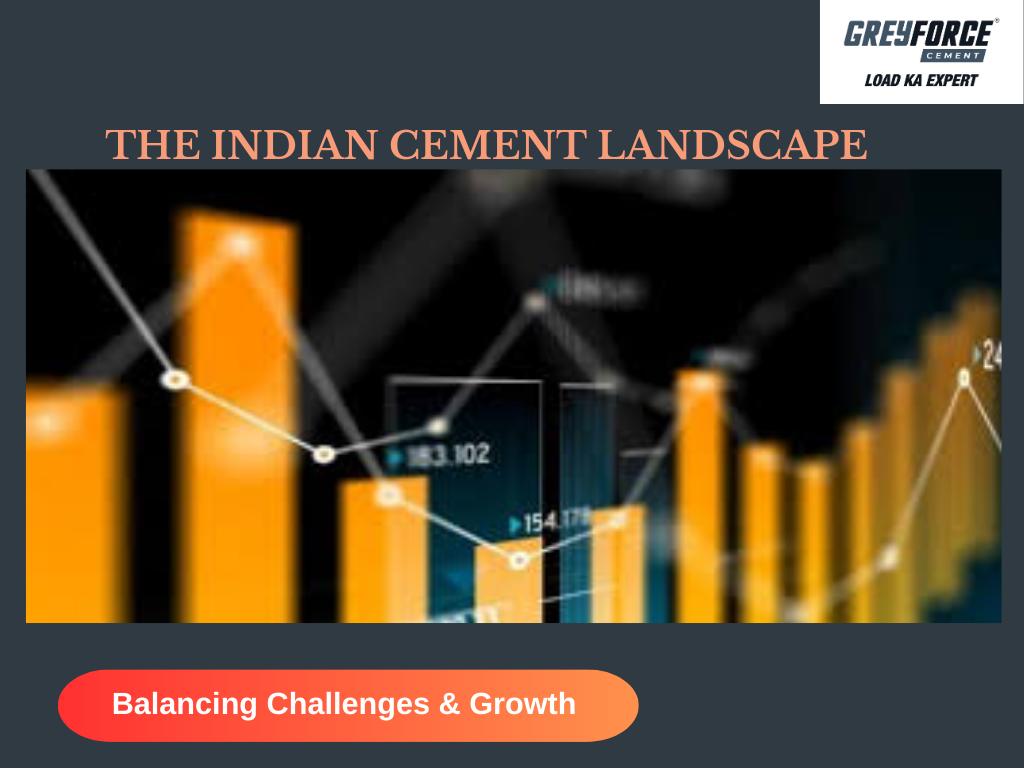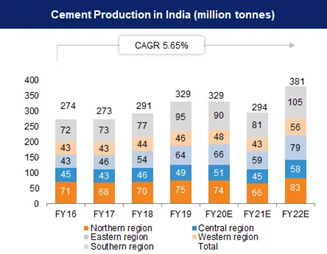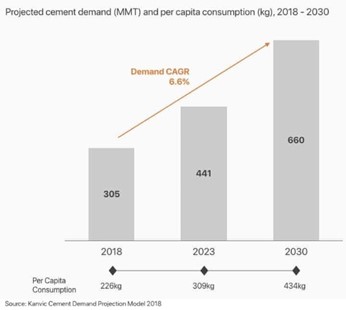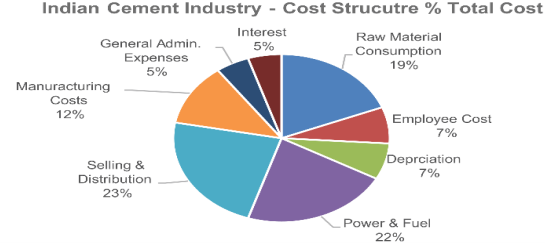
Introduction
India is the world’s second-largest cement producer, following China, and it contributes over 8% to the global installed capacity. With immense potential for infrastructure and construction development, the country’s cement sector is well-positioned for significant growth. In 2023, India’s cement industry produced a substantial 396.7 million tons, and this is projected to reach an impressive 599.7 million tons by 2032. The demand for cement in India has shown a steady compounded annual growth rate (CAGR) of 5.65% from 2016 to 2022, driven by abundant high-quality limestone reserves that support the industry’s expansive growth potential.
Encouraged by this promising outlook, CRISIL Ratings reports that the industry is ramping up capacity, with around 80 million tonnes (MT) expected to be added over the next three years through fiscal 2024—a 25% increase compared to the previous three fiscal years (~64 MT). This surge marks the highest capacity addition in any consecutive three-year period over the past decade.
However, the industry also faces various challenges that require strategic navigation to effectively capitalize on emerging trends. Notably, cement consumption is closely linked to climatic conditions, with demand peaking in March, April, and May, and reaching its lowest in August and September.

Opportunities in the Indian Cement Market
- Sustainable and Green Cement The growing market for sustainable construction materials, including green cement, is expected to see strong growth at a CAGR of 5-6% from 2021 to 2028. Innovations utilizing materials like fly ash and slag help reduce the environmental impact associated with traditional cement production, attracting environmentally-conscious consumers.
- Infrastructure Development India’s ambitious infrastructure plans, with a projected $1.4 trillion investment in infrastructure projects by 2025, present significant growth opportunities for the cement industry. The expansion of roads, railways, airports, and urban infrastructure will drive substantial cement demand. In the 2023-24 budget, the central government allocated ₹2.7 lakh crore to the Ministry of Road Transport and Highways, further boosting cement demand. According to the Cement Manufacturers Association (CMA), the Indian cement industry has a surplus capacity of 150 million tons. However, capacity utilization remains a challenge given the current rate of cement consumption in India.
- Technological Innovations Adopting technological advancements like automation and IoT can lead to significant efficiency gains and cost reductions in cement manufacturing. Predictive maintenance powered by IoT technologies, for example, can reduce equipment downtimes, enhance productivity, and improve operational efficiencies.
- Government Initiatives The ‘PM Gati Shakti – National Master Plan,’ launched by the Prime Minister in October 2021, aims to create a seamless, world-class multimodal transport network across India. This ambitious initiative is expected to significantly boost future cement demand. Additionally, under the ‘housing for all’ segment, the budget estimate for the Pradhan Mantri Awas Yojana in 2023-24 is ₹79,590 crore, further driving demand for cement in the affordable housing sector.

Challenges in the Indian Cement Market
- Environmental Concerns and Regulations Cement production is responsible for about 8% of global CO2 emissions, drawing intense scrutiny from international environmental bodies and governments. To reduce environmental impact, the industry must invest in carbon capture technologies and explore alternative fuels, even though this could increase operational costs by up to 20%.
- Rising Energy Costs Energy expenditures make up a significant 30-40% of total production costs in the cement sector. Fluctuating global energy prices pose challenges to maintaining cost efficiency. In 2022, global energy prices surged by over 50% in various regions, putting pressure on profit margins for cement manufacturers.
- Market Competition The Indian cement market is highly competitive, with numerous players vying for market share. This intense competition has driven down domestic cement prices, forcing companies to innovate and improve customer service to stay profitable.
- Technological Adaptation Despite the potential benefits, only about 10% of Indian cement companies have fully embraced digitalization and automation initiatives. The substantial initial investments required—often in the millions—pose a barrier. However, companies that adopt these technologies can potentially achieve up to a 15% reduction in production costs and significant improvements in quality control.
Conclusion
The Indian cement industry stands on the brink of promising growth, yet it faces substantial challenges that demand strategic foresight and adaptation. Navigating the maze of stringent environmental regulations, optimizing energy efficiency, fortifying supply chains, and embracing technological innovations is no small feat. However, these efforts are crucial for harnessing the burgeoning opportunities in sustainable construction and infrastructure development.
By prioritizing sustainability and fostering innovation, the industry can not only align with global trends but also contribute to a greener future. Imagine a future where every new building stands as a testament to our commitment to the environment, where cutting-edge technologies make production more efficient and less polluting, and where every challenge met is a step toward a more prosperous and sustainable industry.
With determination and innovation, the Indian cement sector can transform these challenges into opportunities, forging a resilient path toward a brighter future for everyone involved.
Looking ahead, GreyForce Industries is excited about our future growth. Over the next three years, we’re planning to ramp up our production to 3 million tonnes. This expansion will help us better meet the growing demand and strengthen our market presence. Additionally, within the next two years, we’re set to expand into Madhya Pradesh, bringing our high-quality cement to new customers and communities. These steps forward are not just about growth; they’re about reinforcing our commitment to excellence and sustainability in every project we undertake. We’re thrilled about what lies ahead and look forward to building a stronger, more sustainable future together.


